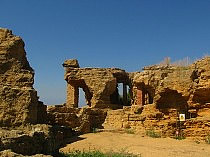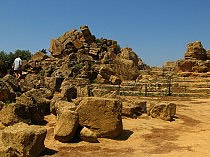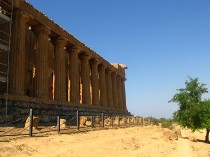
Agrigento - Valley of the temples
Agrigento (Girgenti in Sicilian) is a city on the southern coast of Sicily, Italy, and capital of the province of Agrigento. It is renowned as the site of the ancient Greek city of Akragras (a.k.a. Acragas in Greek, Agrigentum in Latin, and Kerkent in Arabic), one of the leading cities of Magna Graecia during the golden age of Ancient Greece. - From Wikipedia the free encyklopedia
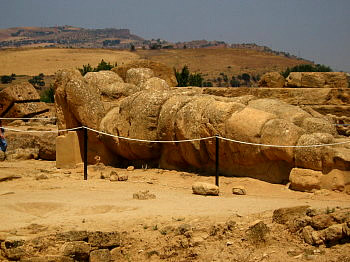 The Agrigento Sicily - archeological site
The Agrigento Sicily - archeological site
The Agrigento Sicily - archeological site was classiified as a UNESCO world heritage site in 1997 as collection of Doric temples. Akragas founded in 581 BC was a subcolony , since its founders of Rhodian and Cretan origin, came from the nearby city Gela, founded a century earlier. The urban layout of Akragas was closely linked to the topography of the land. Excavations have confirmed that the town occupied the depression located between the hills that now host the modern town to the north and the temples to the south. The centre of civic life consisted of two public areas, the north and south agorae identified on the knoll of San Nicola and in modern-day Piazzale Hardcastle. The historians of ancient times spoke of Agrigento being a populous city with a two or three hundred thousand inhabitants.
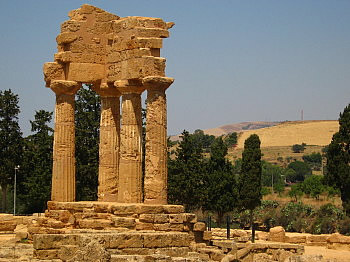 TempleOf the Dioscuri twins Castor and Polux
TempleOf the Dioscuri twins Castor and Polux
In the 5th century BC this horse-rearing city famous throughout the ancient world, was surrounded by beautiful Doric temples with two agorae and splendid porticoes, a feverishly active emporium, strong fortifications and intensely cultivated land. Poets, artists and adventurers came here to enjoy the opulence of this city dedicated to Demeter and Persephone, as well as its sky, sea and exceptionally mild climate. The residents of Agrigento lived in such luxury that, according to the historian Diodorus Siculus, a public decree restricted the night facilities of sentinels during the Carthaginian attack to one mattres, one blanket one sheepskin and two pilows.
The rich generous Gellias was without doubt the symbol of Akragas' opulence. His enormous fortune allowed him to host any foreigner who came to visit his beloved city. His magnanimity led to him becoming famous amongst his fellow citizens to the extent of him being appointed ambassador, despite his lack of serious involvment in political life.
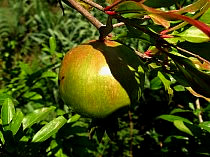
Kolymbetra Garden in the Valley of the Temples
In the archeological area of the Agrigento Sicily - Valley of the Temples in Agrigento, defined by Pindar as »The moast beutiful city of the mortals«, there is a corner which is still unknown to many; a pleasant corner where you can take refuge from scorching heat of the sun-baked ancient ruins;
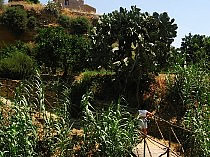
Garden near Valley of the templeIn the bottom of the valley today, this vegetation consists of citrus garden with lemons, citrons, mandarins and ancient varieties of orange; of canes, poplars, tamarisks and wilows that grow lushly near the waterways; of almond and olive trees spread over non irrigated areas; of vegetable gardens and vineyards, and finally a thick Mediterranean maquis (myrtle, lentiscus, terebinth, phyllyrea, euphorbia, broom) which grows all over.
